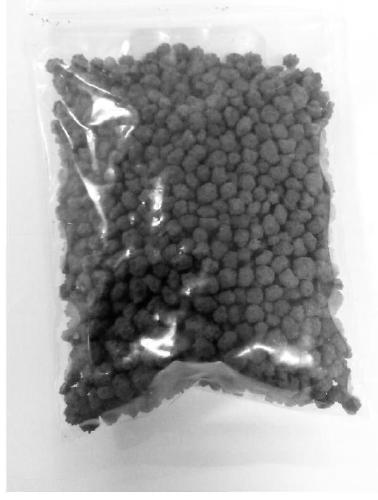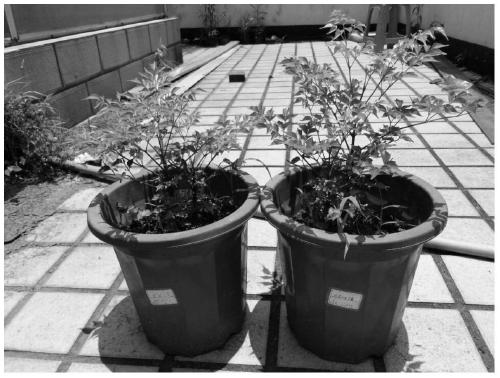A kind of method for preparing slow-release fertilizer by lignocellulosic ethanol fermentation residue
A lignocellulose and ethanol fermentation technology, applied in the direction of calcium fertilizer, inorganic fertilizer, urea compound fertilizer, etc., can solve the problems of poor slow-release effect, secondary pollution of soil, complicated process, etc., and achieve the promotion of agricultural and forestry fertilization mode, The effect of increasing soil organic matter content and simple preparation method
- Summary
- Abstract
- Description
- Claims
- Application Information
AI Technical Summary
Problems solved by technology
Method used
Image
Examples
Embodiment 1
[0044] Lignocellulosic ethanol fermentation residues are dried and pulverized, and passed through a 100-mesh sieve for later use. Take 20g of dried and pulverized lignocellulose ethanol fermentation residue into a 500mL three-neck flask, add 80mL of pure water for mixing, use NaOH solution to adjust the pH to 8.0, and place it in an ultrasonic cleaner for 6 hours.
[0045] In the three-neck flask containing the lignocellulose ethanol fermentation residue solution, 5 g of formaldehyde solution was slowly added dropwise, and mechanically stirred for 6 hours in a constant temperature water bath at 90°C.
[0046] Slowly add 10 g of polyvinyl alcohol (AH-26, alcoholysis degree: 98%) into 90 mL of pure water, stir rapidly while adding, and gradually raise the temperature from room temperature to 40°C.
[0047] The polyvinyl alcohol solution is slowly added dropwise to the lignocellulosic ethanol fermentation residue and formaldehyde solution, in a water bath at 90° C., and mechanica...
Embodiment 2
[0052]Lignocellulosic ethanol fermentation residues are dried and pulverized, and passed through a 100-mesh sieve for later use. Take 20g of dried and pulverized lignocellulose ethanol fermentation residue into a 500mL three-neck flask, add 80mL of pure water for mixing, use NaOH solution to adjust the pH to 8.0, and place it in an ultrasonic cleaner for 6 hours.
[0053] Add 5 g of acetic anhydride to a three-neck flask containing the solution of lignocellulosic ethanol fermentation residue, and mechanically stir for 6 h in a constant temperature water bath at 90°C.
[0054] Slowly add 10 g of polyvinyl alcohol (AH-26, alcoholysis degree: 98%) into 90 mL of pure water, stir rapidly while adding, and gradually raise the temperature from room temperature to 40°C.
[0055] The polyvinyl alcohol solution is slowly added dropwise to the lignocellulosic ethanol fermentation residue and formaldehyde solution, in a water bath at 90° C., and mechanically stirred for 10 hours to obtain...
Embodiment 3
[0060] Lignocellulosic ethanol fermentation residues are dried and pulverized, and passed through a 100-mesh sieve for later use. Take 20g of dried and pulverized lignocellulose ethanol fermentation residue into a 500mL three-neck flask, add 80mL of pure water for mixing, use NaOH solution to adjust the pH to 8.0, and place it in an ultrasonic cleaner for 6 hours.
[0061] In the three-neck flask containing the lignocellulose ethanol fermentation residue solution, 5 g of formaldehyde solution was slowly added dropwise, and mechanically stirred for 6 hours in a constant temperature water bath at 90°C.
[0062] Slowly add 10 g of polyvinyl alcohol (AH-26, alcoholysis degree: 98%) into 90 mL of pure water, stir rapidly while adding, and gradually raise the temperature from room temperature to 40°C.
[0063] The polyvinyl alcohol solution is slowly added dropwise to the lignocellulosic ethanol fermentation residue and formaldehyde solution, in a water bath at 90° C., and mechanica...
PUM
| Property | Measurement | Unit |
|---|---|---|
| alcoholysis degree | aaaaa | aaaaa |
Abstract
Description
Claims
Application Information
 Login to View More
Login to View More - R&D
- Intellectual Property
- Life Sciences
- Materials
- Tech Scout
- Unparalleled Data Quality
- Higher Quality Content
- 60% Fewer Hallucinations
Browse by: Latest US Patents, China's latest patents, Technical Efficacy Thesaurus, Application Domain, Technology Topic, Popular Technical Reports.
© 2025 PatSnap. All rights reserved.Legal|Privacy policy|Modern Slavery Act Transparency Statement|Sitemap|About US| Contact US: help@patsnap.com


